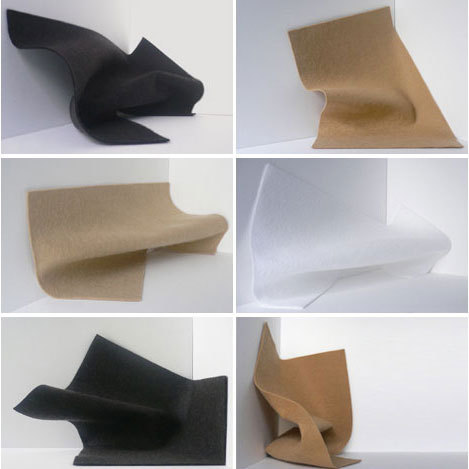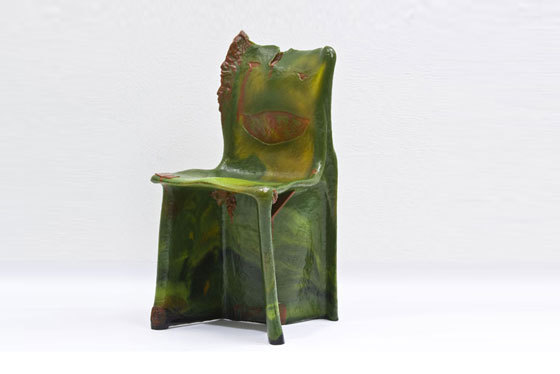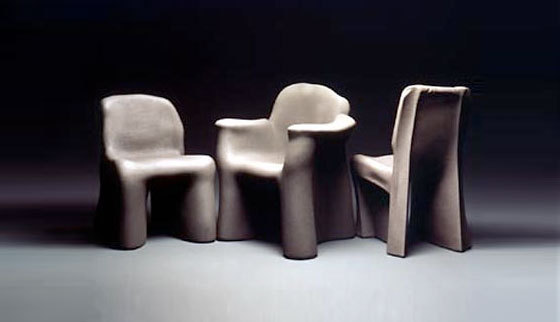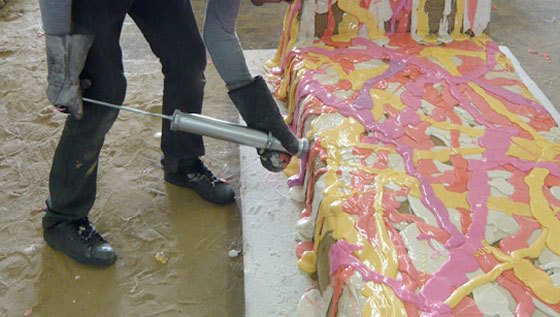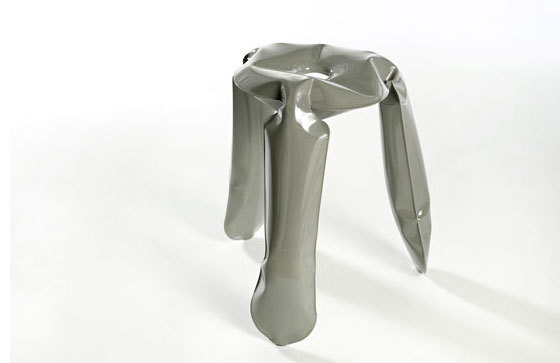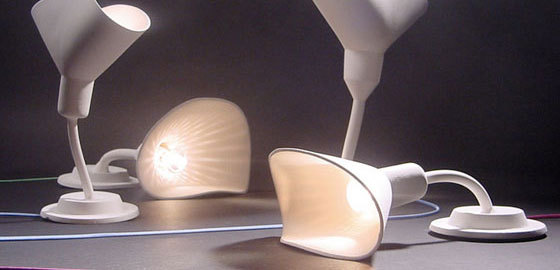Chance as a Design Strategy
Scritto da Susanne Fritz
Svizzera
16.01.10
Many great achievements have been born out of chance – for example, the invention of penicillin. In the 1950s and 60s, chance as a methodology was still a revolutionary way of working for artists and designers, producing controversial results.
Many great achievements have been born out of chance – for example, the invention of penicillin. In the 1950s and 60s, chance as a methodology was still a revolutionary way of working for artists and designers, producing controversial results.
In contrast to the objectivity and functionalism of the post-war period, promoted by the German Design Council for example, an anti-formal tendency began to appear. Joseph Beuys applied fat to a chair; Michelangelo Pistoletto created piles of rags.
Exponents of the Arte Povera movement produced artworks using a material's essence and possibility: Giuseppe Penone played with, among other things, the growth cycles of trees and potatoes. Germano Celant, who coined the term "Arte Povera", writes in his book of the same name: "Everything can be found in these works: historical leftovers, short-lived material remains, constellations made from organic and mineral matter..."
Material experiments of the 1960s
A veritable explosion of experimental form within early design history occurred in the 1960s. New materials were available, and artists and designers began to try them out. Polyurethane foam, available since the 1940s, proved highly attractive. The resulting forms are, due to the material's uncontrollable, expansive mass, more or less random. Gunnar Aagaard Andersen was one of the PUR pioneers, producing a series of chairs from 1964 to 1965 entitled 'Portrait of My Mother's Chesterfield Chair'. With all their opulence, they avoid being inferior copies of the model to which they refer, which is, of course, steeped in tradition.
Lynda Benglis made sculptures out of polyurethane, which were called "Fallen Paintings". Her "Quartered Meteor", created in 1969, marked the beginning of an evolution of chairs seemingly poured against the wall. Robert Stadler's "Pools and Pouf" and Ubald Klug's "Terrazza" aren't random, though, but instead are examples of serially produced upholstered furniture. Olivier Gregoire's "Tapisofa" also huddles against the wall, using it as means of static support, but is a genuinely random piece of furniture, with an unpredictable final form.
Armchair (Portrait of my Mother’s Chesterfield Chair), 1964, Design: Gunnar Aagaard Andersen, Polyurethane © Tecta/MAK

Armchair (Portrait of my Mother’s Chesterfield Chair), 1964, Design: Gunnar Aagaard Andersen, Polyurethane © Tecta/MAK
×Lynda Benglis made sculptures out of polyurethane, which were called "Fallen Paintings". Her "Quartered Meteor", created in 1969, marked the beginning of an evolution of chairs seemingly poured against the wall. Robert Stadler's "Pools and Pouf" and Ubald Klug's "Terrazza" aren't random, though, but instead are examples of serially produced upholstered furniture. Olivier Gregoire's "Tapisofa" also huddles against the wall, using it as means of static support, but is a genuinely random piece of furniture, with an unpredictable final form.
Quartered Meteor, 1970, Lynda Benglis for Carl Andre Pigmentierter Polyurethane © Media Center for Art History & Archaeology | Columbia University
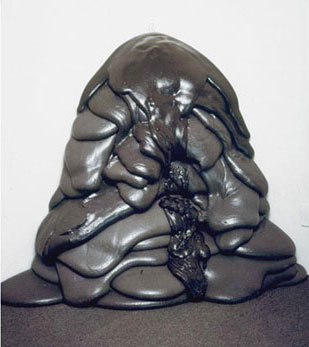
Quartered Meteor, 1970, Lynda Benglis for Carl Andre Pigmentierter Polyurethane © Media Center for Art History & Archaeology | Columbia University
×Terrazza DS 1025, 1973, Design: Ubald Klug for De Sede AG, Polster auf Holzsockel, Bezug Leder © Museum für Gestaltung Zürich, Design Collection/ Franz Xaver Jaggy
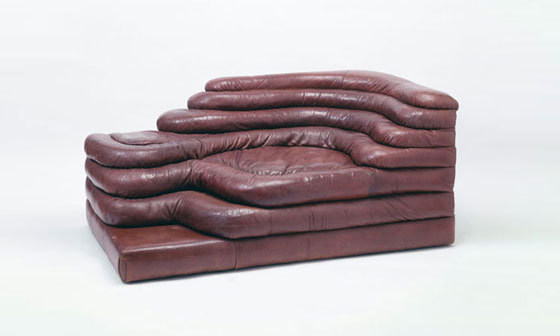
Terrazza DS 1025, 1973, Design: Ubald Klug for De Sede AG, Polster auf Holzsockel, Bezug Leder © Museum für Gestaltung Zürich, Design Collection/ Franz Xaver Jaggy
×Pools and Pouf, 2004, Design: Robert Stadler for Edition Klaus Engelhorn: leather, wood, PVC © MAK/Georg Mayer
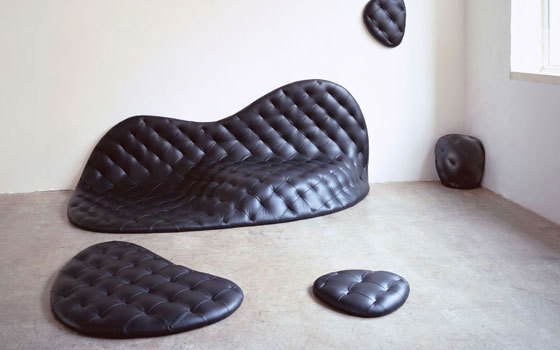
Pools and Pouf, 2004, Design: Robert Stadler for Edition Klaus Engelhorn: leather, wood, PVC © MAK/Georg Mayer
×Tapisofa, 1964, Design: Olivier Gregoire, Concept for Ikea workshop © Olivier Gregoire
New Forms of Living
"Sacco", designed in 1968 by Gatti, Paolini und Teodoro, is an expression of, and cult furniture piece for, the '68 Generation's way of life and of home living. Instead of sitting politely, you sprawl in the free-form chair, which only allows you to adopt the most casual of positions. Later iterations of the "Sacco" chair, like Greg Lynn's "Ravioli Chair" and Karim Rashid's "Superblob", are computer-generated stills, so to speak, of the original, interactive "Sacco", which can be seen as starting point of all the "blobjects" that followed.
Sacco, 1968, Design: Piero Gatti, Cesare Paolini, Franco Teodoro für Zanotta,viny-coated textile cover filled with styrofoam pearls © MAK/Georg Mayer
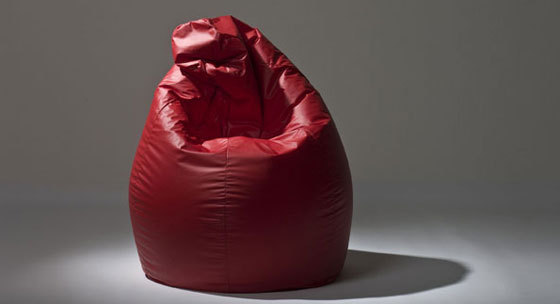
Sacco, 1968, Design: Piero Gatti, Cesare Paolini, Franco Teodoro für Zanotta,viny-coated textile cover filled with styrofoam pearls © MAK/Georg Mayer
×Potatoes are the new chemistry
The "Pratt Chairs" (1984) are a series of nine pieces by Gaetano Pesce, one of the pioneeers of the formless. They are made from monochromatic polyurethane resin, which Pesce modelled by hand into his desired shapes. The plasticity of the material, which after a certain period of time hardens and sets in a particular position, determines the form of these one-off chairs. Later came the "Dalilah Chairs", which remind one of plasticine; here, solid polyurtethane and urethane resin are combined.
Pratt Chair No. 7, 1983, Design: Gaetano Pesce © MAK/Georg Mayer
Dalilah Chairs, 1992, Design: Gaetano Pesce © Gaetano Pesce
Plastics possess amazing simple formal properties. But they also present a huge set of environmental problems because of their very durability: they don't decompose.
Jerszy Seymour has recently gone back to the roots of plastic experimentation. His installation "Living Systems" is redolent of Benglis's polyurethane experimental work, although he uses biopolymers for his poured furniture, which he cooks up out of potatoes and milk. Seymour is opposed, like Andersen, Pistoletto and Beuys, to mass production, whose origins he sees in the functionalism of the Bauhaus, and he makes a plea for the sustainable and individual object.
Living Systems, 2008, Jerszey Seymour for vitra © Jerszey Seymour
The illusion of disengaging form and material
Oskar Zieta's "Plopp" chair looks, at first glance, like a spin-off from Zanotta's "Blow Chair", designed by De Pas, D'Urbino, Lomazzi and Scolari and first produced in 1968. But this isn't about inflatable-matress furniture. Its ingenuity lies in its totally innovative working of steel. Thanks to a revolutionary technology called "open internal pressure casting", which he developed in conjunction with the Swiss Federal Institute of Technology Zurich (ETH), the piece inflates, by means of high water pressure, two pieces of lead that have been welded together, thus creating a new form.
Plopp, 2008, Design: Oskar Zieta, manufacturer HAY
Blow, 1967, Design: Gionatan De Pas, Donato D’Urbino, Paolo Lomazzi, Carla Scolari, for Zanotta, PVC © Museum für Gestaltung Zürich, Design Collection/ Franz Xaver Jaggy

Blow, 1967, Design: Gionatan De Pas, Donato D’Urbino, Paolo Lomazzi, Carla Scolari, for Zanotta, PVC © Museum für Gestaltung Zürich, Design Collection/ Franz Xaver Jaggy
×Other materials one would think lacking in an elastic quality, such as porcelain and glass, become soft when in different phases of matter, their seemingly runny form then freezing, as it were, when the material hardens.
The "Spineless Lamp" by Frederik Roijé for droog develops a unique form during firing, due to the differing thicknesses of its porcelain. With Masahiro Fukuyama's "PX 02" lights, too, one can see that the conditions of hard and soft are merely a question of the surrounding temperature. This series of Pyrex lamps came about during a workshop involving a group of young designers and Pyrex specialist Massimo Lunnardon. The "PX 02" objects appear to arrest that moment between fluid and hard.
Spineless Lamp, Design Frederik Roijé, fordroog, © droog
PX 02, Design Masahiro Fukuyama for Fabrica workshop, manufacturer metalarte
In experimenting with form, new variations of two established methods continue to present themselves: old materials are used in a new way, or new materials are exhausted. What continues to remain fascinating, however, is the endless number of results, which ultimately reflect the process of creating form in the smallest of detail.
The exhibition Formlose Möbel (Formless Furniture) runs until 14 February 2012 at the Museum für Gestaltung, Zurich.




